Project Management and Methodologies at Transport for London Project
VerifiedAdded on 2023/06/17
|20
|2121
|56
Report
AI Summary
This report provides a comprehensive analysis of project management principles applied to Transport for London (TfL). It delves into various project management methodologies, including Agile and Waterfall, highlighting their suitability for TfL's road and bus network improvement projects. The report includes a stakeholder analysis, categorizing stakeholders based on their power and interest levels, and a risk assessment, identifying potential risks and mitigation strategies. Furthermore, it features a Work Breakdown Structure (WBS), a Gantt chart, and a network diagram to illustrate project tasks and timelines. The report concludes with recommendations for TfL, emphasizing the importance of market research, digital technology adoption, and participative decision-making to enhance project efficiency and achieve desired goals and objectives. This document is available on Desklib, a platform offering study tools and solved assignments for students.
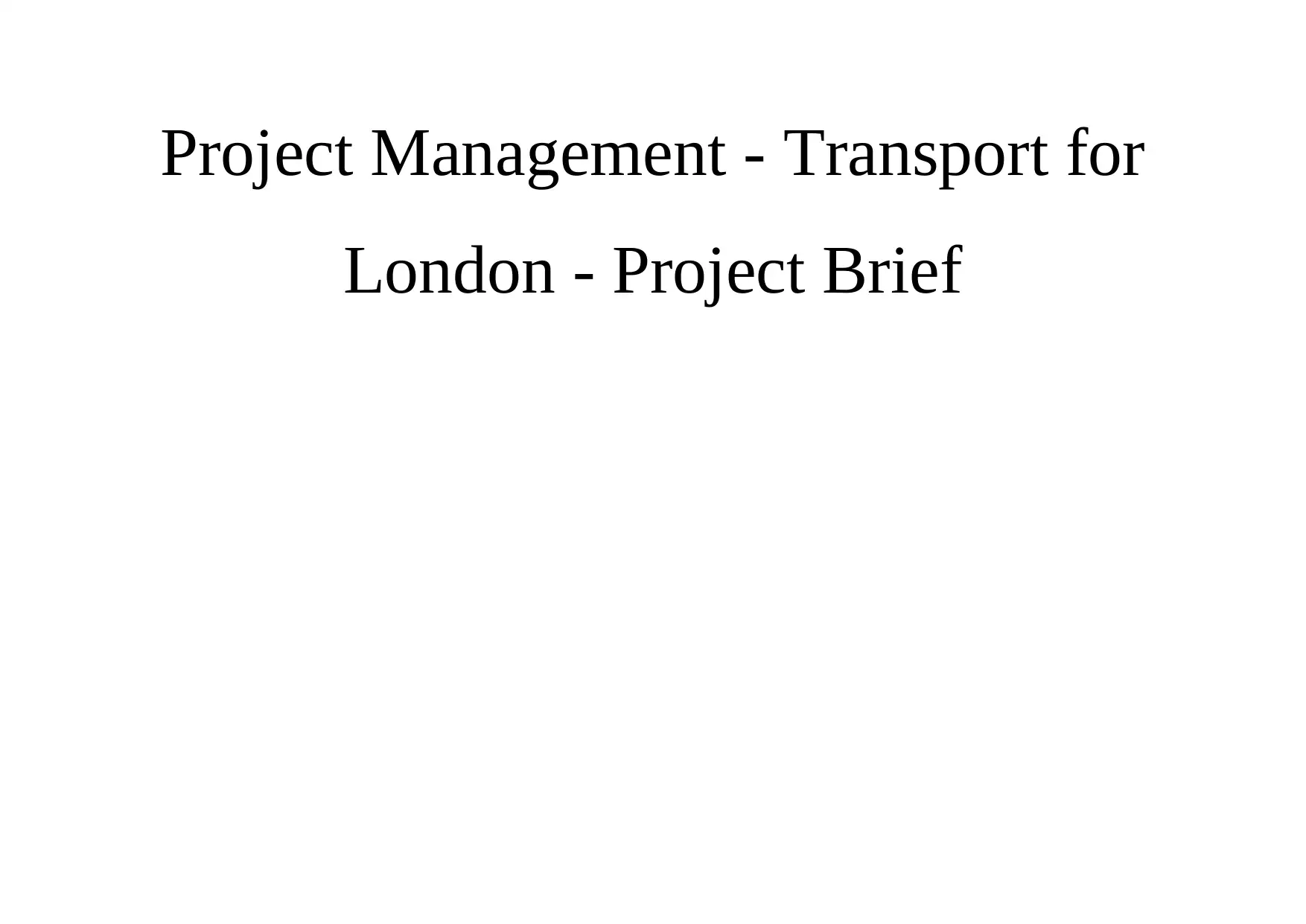
Project Management - Transport for
London - Project Brief
London - Project Brief
Paraphrase This Document
Need a fresh take? Get an instant paraphrase of this document with our AI Paraphraser
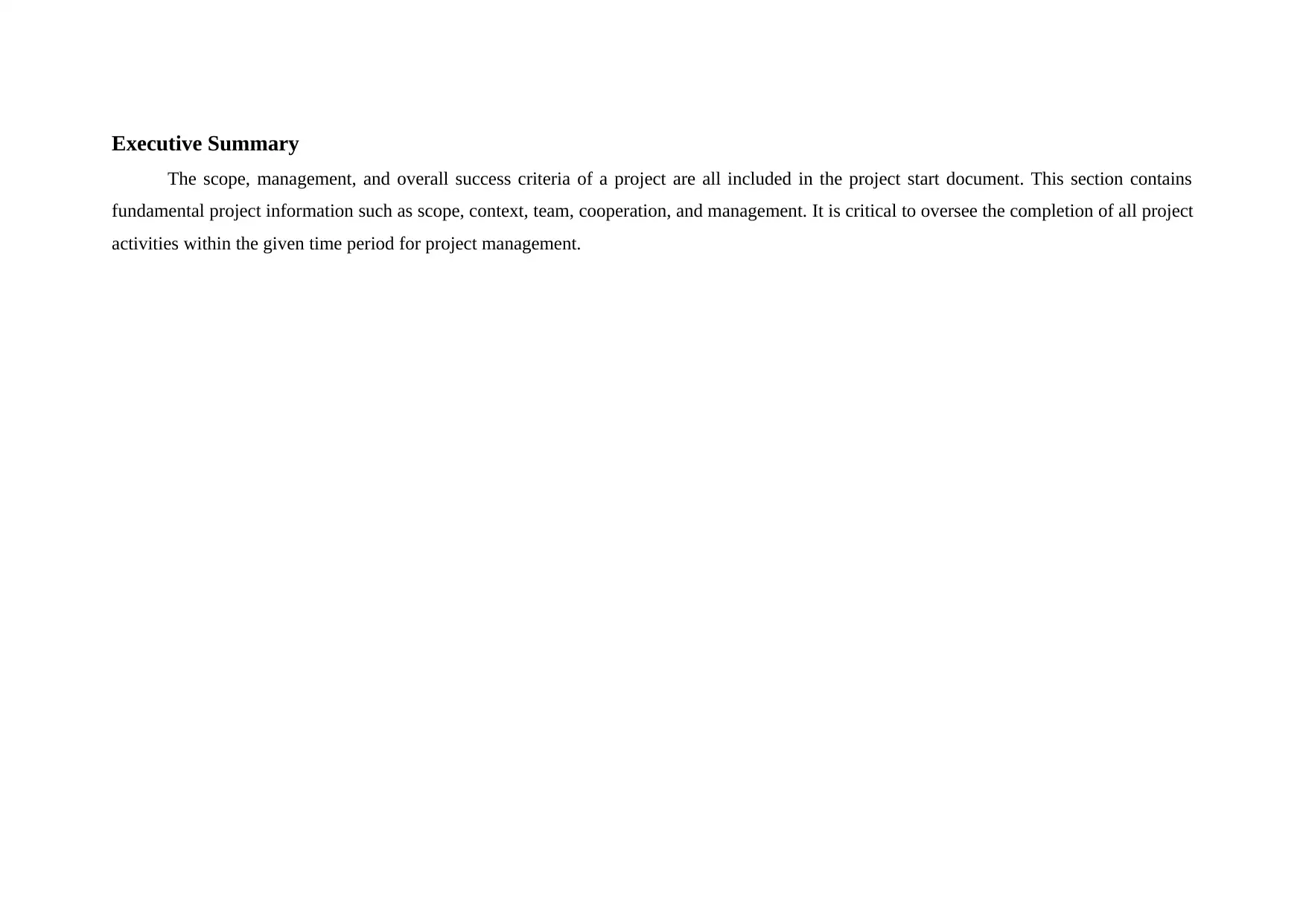
Executive Summary
The scope, management, and overall success criteria of a project are all included in the project start document. This section contains
fundamental project information such as scope, context, team, cooperation, and management. It is critical to oversee the completion of all project
activities within the given time period for project management.
The scope, management, and overall success criteria of a project are all included in the project start document. This section contains
fundamental project information such as scope, context, team, cooperation, and management. It is critical to oversee the completion of all project
activities within the given time period for project management.
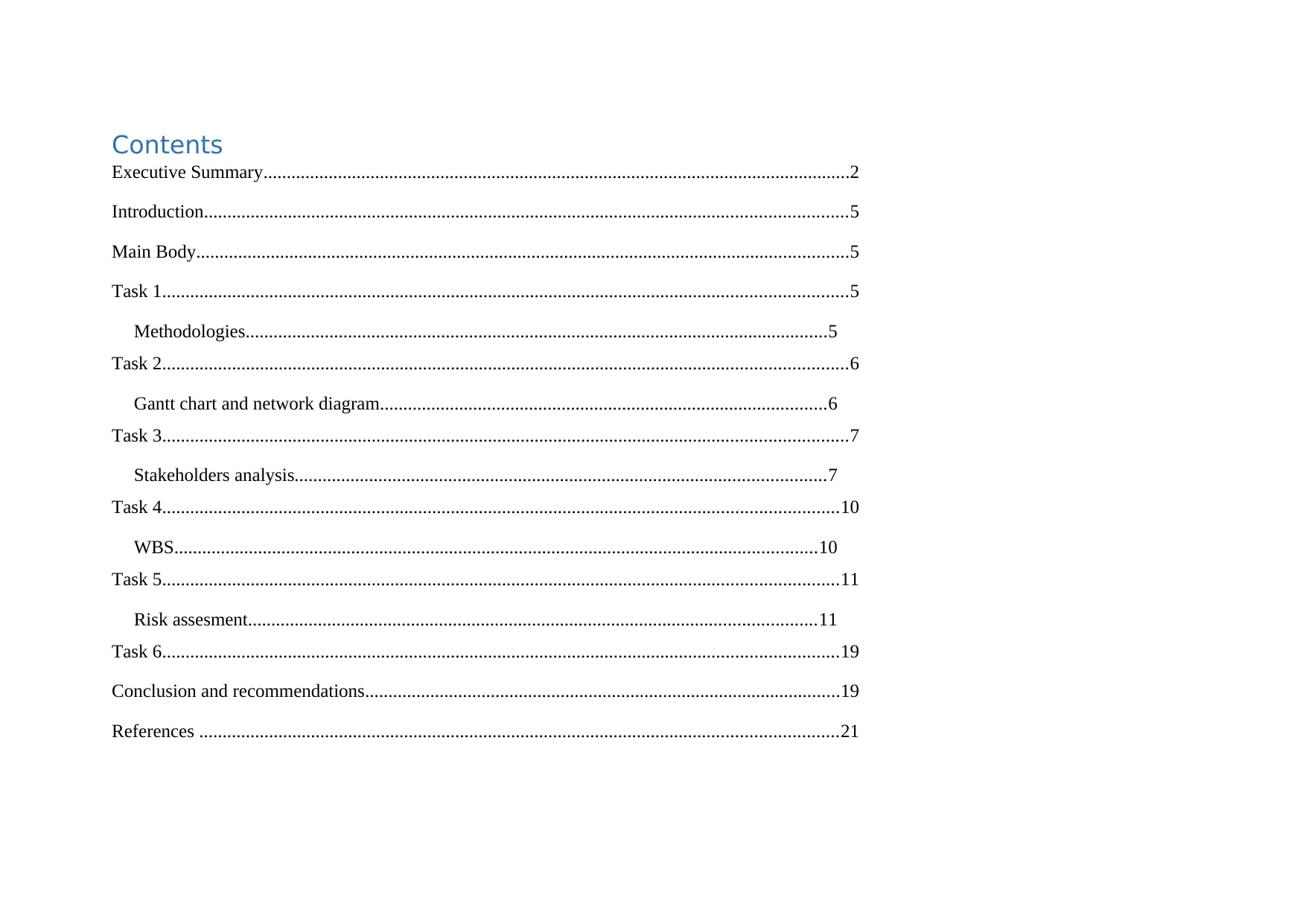
Contents
Executive Summary..............................................................................................................................2
Introduction..........................................................................................................................................5
Main Body............................................................................................................................................5
Task 1...................................................................................................................................................5
Methodologies.............................................................................................................................5
Task 2...................................................................................................................................................6
Gantt chart and network diagram................................................................................................6
Task 3...................................................................................................................................................7
Stakeholders analysis..................................................................................................................7
Task 4.................................................................................................................................................10
WBS..........................................................................................................................................10
Task 5.................................................................................................................................................11
Risk assesment..........................................................................................................................11
Task 6.................................................................................................................................................19
Conclusion and recommendations......................................................................................................19
References .........................................................................................................................................21
Executive Summary..............................................................................................................................2
Introduction..........................................................................................................................................5
Main Body............................................................................................................................................5
Task 1...................................................................................................................................................5
Methodologies.............................................................................................................................5
Task 2...................................................................................................................................................6
Gantt chart and network diagram................................................................................................6
Task 3...................................................................................................................................................7
Stakeholders analysis..................................................................................................................7
Task 4.................................................................................................................................................10
WBS..........................................................................................................................................10
Task 5.................................................................................................................................................11
Risk assesment..........................................................................................................................11
Task 6.................................................................................................................................................19
Conclusion and recommendations......................................................................................................19
References .........................................................................................................................................21
⊘ This is a preview!⊘
Do you want full access?
Subscribe today to unlock all pages.

Trusted by 1+ million students worldwide

Paraphrase This Document
Need a fresh take? Get an instant paraphrase of this document with our AI Paraphraser
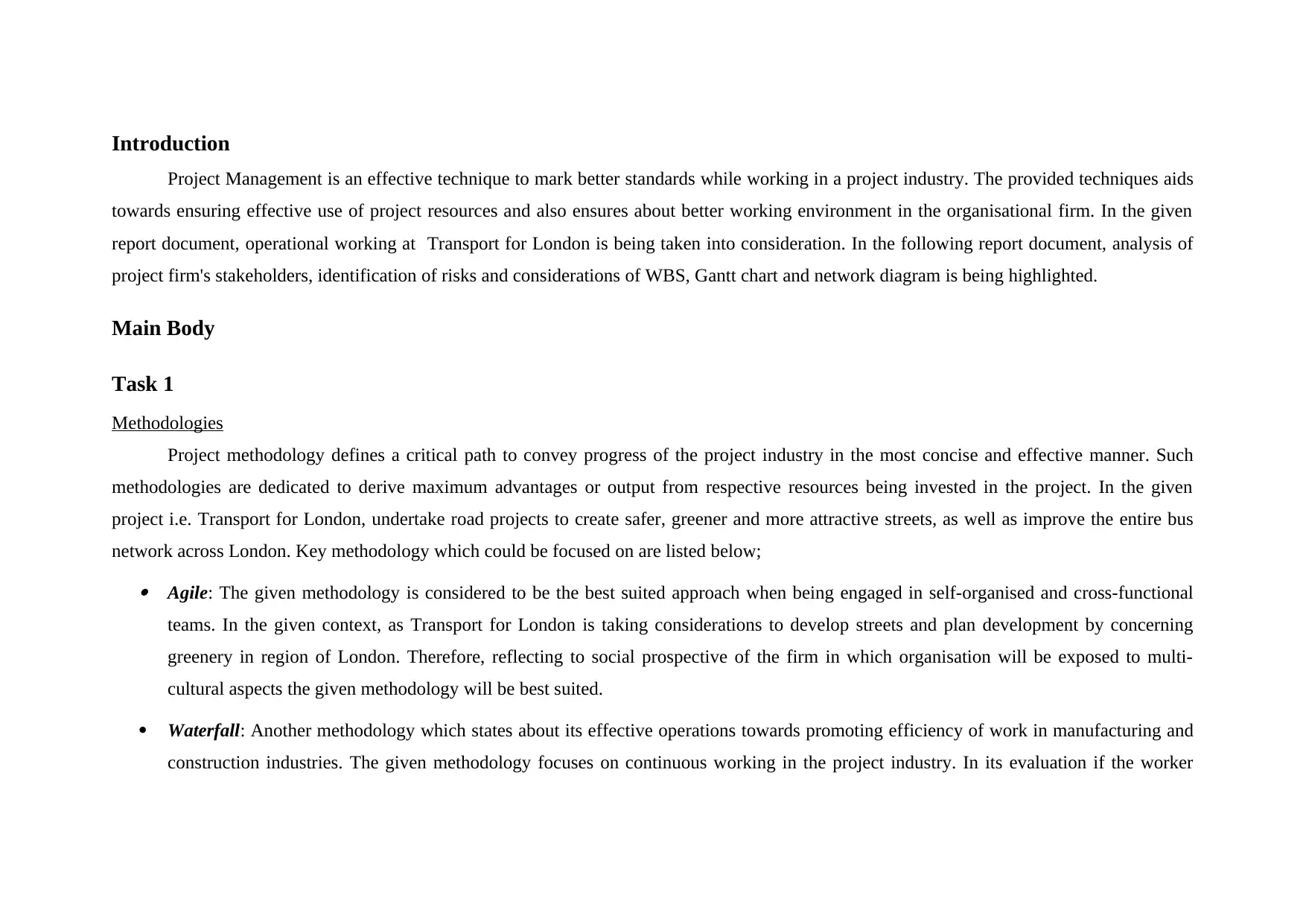
Introduction
Project Management is an effective technique to mark better standards while working in a project industry. The provided techniques aids
towards ensuring effective use of project resources and also ensures about better working environment in the organisational firm. In the given
report document, operational working at Transport for London is being taken into consideration. In the following report document, analysis of
project firm's stakeholders, identification of risks and considerations of WBS, Gantt chart and network diagram is being highlighted.
Main Body
Task 1
Methodologies
Project methodology defines a critical path to convey progress of the project industry in the most concise and effective manner. Such
methodologies are dedicated to derive maximum advantages or output from respective resources being invested in the project. In the given
project i.e. Transport for London, undertake road projects to create safer, greener and more attractive streets, as well as improve the entire bus
network across London. Key methodology which could be focused on are listed below; Agile: The given methodology is considered to be the best suited approach when being engaged in self-organised and cross-functional
teams. In the given context, as Transport for London is taking considerations to develop streets and plan development by concerning
greenery in region of London. Therefore, reflecting to social prospective of the firm in which organisation will be exposed to multi-
cultural aspects the given methodology will be best suited.
Waterfall: Another methodology which states about its effective operations towards promoting efficiency of work in manufacturing and
construction industries. The given methodology focuses on continuous working in the project industry. In its evaluation if the worker
Project Management is an effective technique to mark better standards while working in a project industry. The provided techniques aids
towards ensuring effective use of project resources and also ensures about better working environment in the organisational firm. In the given
report document, operational working at Transport for London is being taken into consideration. In the following report document, analysis of
project firm's stakeholders, identification of risks and considerations of WBS, Gantt chart and network diagram is being highlighted.
Main Body
Task 1
Methodologies
Project methodology defines a critical path to convey progress of the project industry in the most concise and effective manner. Such
methodologies are dedicated to derive maximum advantages or output from respective resources being invested in the project. In the given
project i.e. Transport for London, undertake road projects to create safer, greener and more attractive streets, as well as improve the entire bus
network across London. Key methodology which could be focused on are listed below; Agile: The given methodology is considered to be the best suited approach when being engaged in self-organised and cross-functional
teams. In the given context, as Transport for London is taking considerations to develop streets and plan development by concerning
greenery in region of London. Therefore, reflecting to social prospective of the firm in which organisation will be exposed to multi-
cultural aspects the given methodology will be best suited.
Waterfall: Another methodology which states about its effective operations towards promoting efficiency of work in manufacturing and
construction industries. The given methodology focuses on continuous working in the project industry. In its evaluation if the worker
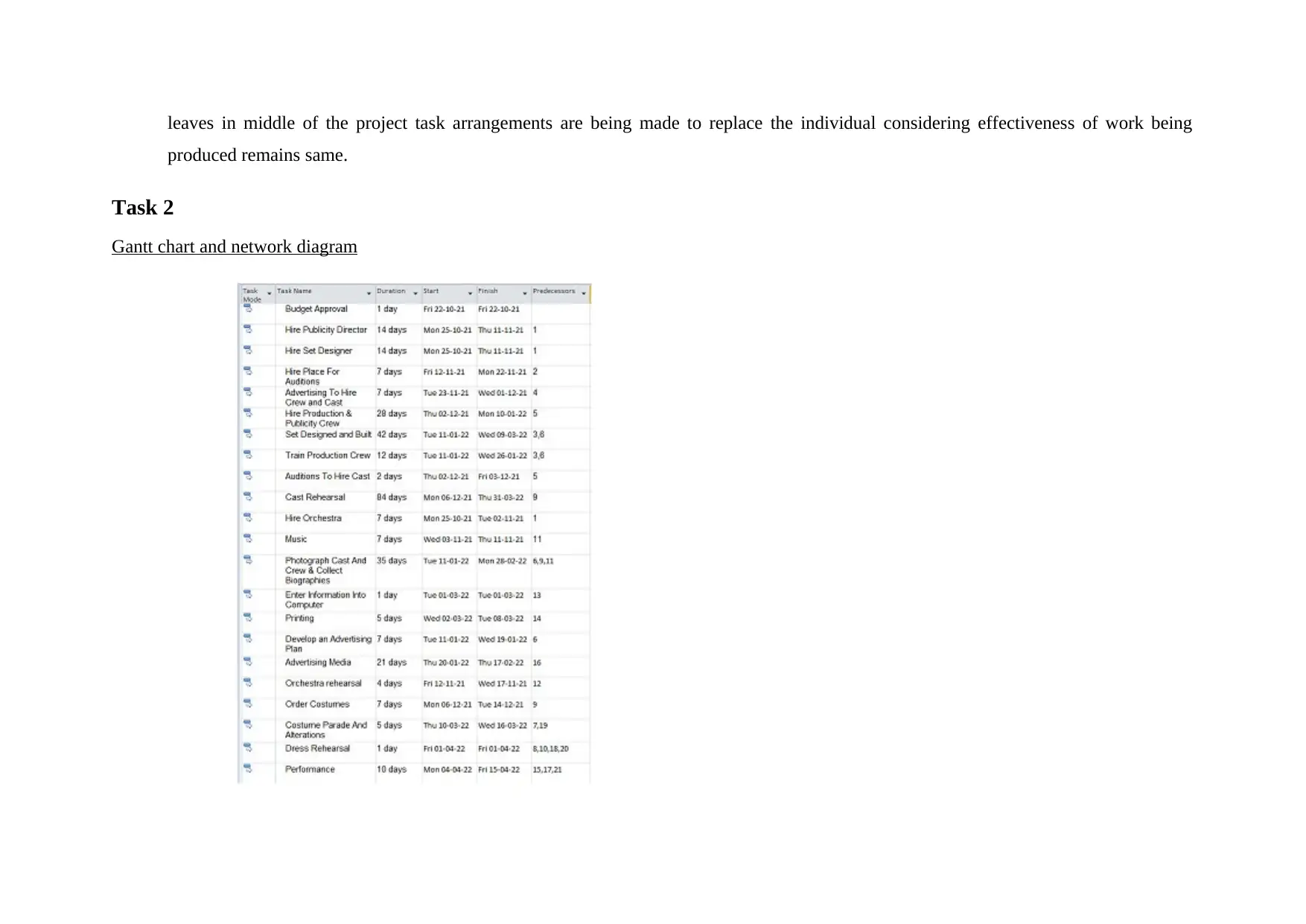
leaves in middle of the project task arrangements are being made to replace the individual considering effectiveness of work being
produced remains same.
Task 2
Gantt chart and network diagram
produced remains same.
Task 2
Gantt chart and network diagram
⊘ This is a preview!⊘
Do you want full access?
Subscribe today to unlock all pages.

Trusted by 1+ million students worldwide
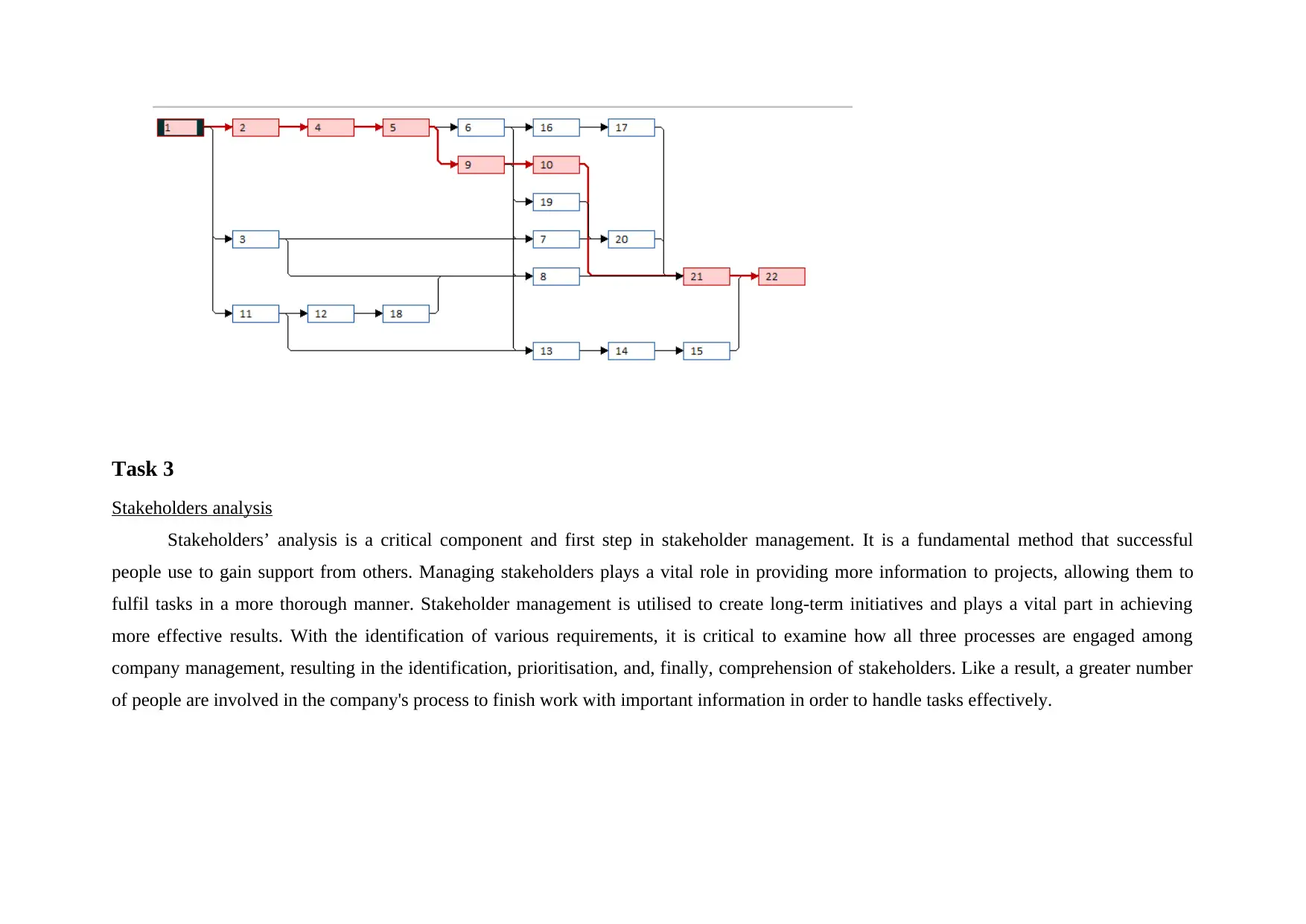
Task 3
Stakeholders analysis
Stakeholders’ analysis is a critical component and first step in stakeholder management. It is a fundamental method that successful
people use to gain support from others. Managing stakeholders plays a vital role in providing more information to projects, allowing them to
fulfil tasks in a more thorough manner. Stakeholder management is utilised to create long-term initiatives and plays a vital part in achieving
more effective results. With the identification of various requirements, it is critical to examine how all three processes are engaged among
company management, resulting in the identification, prioritisation, and, finally, comprehension of stakeholders. Like a result, a greater number
of people are involved in the company's process to finish work with important information in order to handle tasks effectively.
Stakeholders analysis
Stakeholders’ analysis is a critical component and first step in stakeholder management. It is a fundamental method that successful
people use to gain support from others. Managing stakeholders plays a vital role in providing more information to projects, allowing them to
fulfil tasks in a more thorough manner. Stakeholder management is utilised to create long-term initiatives and plays a vital part in achieving
more effective results. With the identification of various requirements, it is critical to examine how all three processes are engaged among
company management, resulting in the identification, prioritisation, and, finally, comprehension of stakeholders. Like a result, a greater number
of people are involved in the company's process to finish work with important information in order to handle tasks effectively.
Paraphrase This Document
Need a fresh take? Get an instant paraphrase of this document with our AI Paraphraser
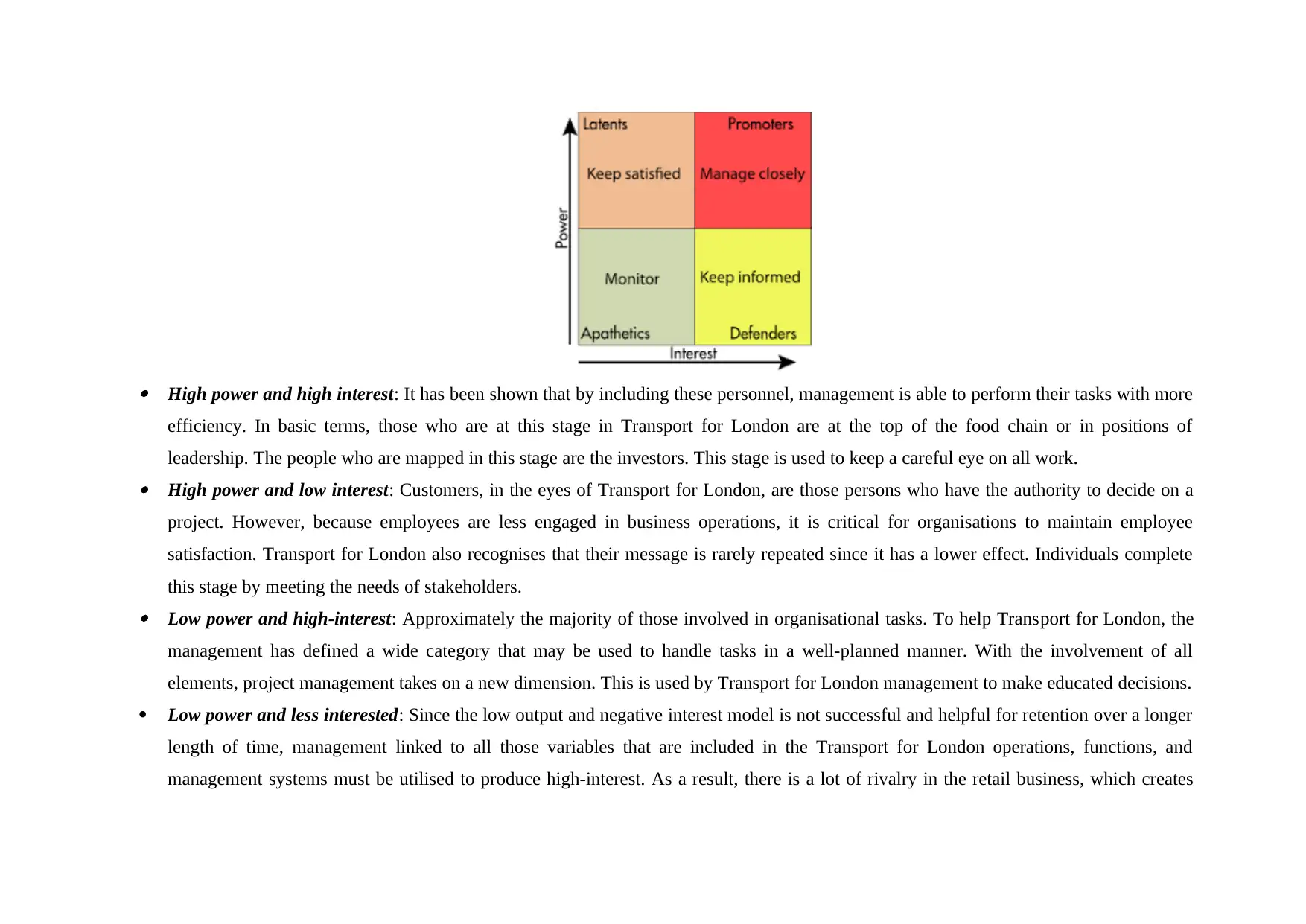
High power and high interest: It has been shown that by including these personnel, management is able to perform their tasks with more
efficiency. In basic terms, those who are at this stage in Transport for London are at the top of the food chain or in positions of
leadership. The people who are mapped in this stage are the investors. This stage is used to keep a careful eye on all work. High power and low interest: Customers, in the eyes of Transport for London, are those persons who have the authority to decide on a
project. However, because employees are less engaged in business operations, it is critical for organisations to maintain employee
satisfaction. Transport for London also recognises that their message is rarely repeated since it has a lower effect. Individuals complete
this stage by meeting the needs of stakeholders. Low power and high-interest: Approximately the majority of those involved in organisational tasks. To help Transport for London, the
management has defined a wide category that may be used to handle tasks in a well-planned manner. With the involvement of all
elements, project management takes on a new dimension. This is used by Transport for London management to make educated decisions.
Low power and less interested: Since the low output and negative interest model is not successful and helpful for retention over a longer
length of time, management linked to all those variables that are included in the Transport for London operations, functions, and
management systems must be utilised to produce high-interest. As a result, there is a lot of rivalry in the retail business, which creates
efficiency. In basic terms, those who are at this stage in Transport for London are at the top of the food chain or in positions of
leadership. The people who are mapped in this stage are the investors. This stage is used to keep a careful eye on all work. High power and low interest: Customers, in the eyes of Transport for London, are those persons who have the authority to decide on a
project. However, because employees are less engaged in business operations, it is critical for organisations to maintain employee
satisfaction. Transport for London also recognises that their message is rarely repeated since it has a lower effect. Individuals complete
this stage by meeting the needs of stakeholders. Low power and high-interest: Approximately the majority of those involved in organisational tasks. To help Transport for London, the
management has defined a wide category that may be used to handle tasks in a well-planned manner. With the involvement of all
elements, project management takes on a new dimension. This is used by Transport for London management to make educated decisions.
Low power and less interested: Since the low output and negative interest model is not successful and helpful for retention over a longer
length of time, management linked to all those variables that are included in the Transport for London operations, functions, and
management systems must be utilised to produce high-interest. As a result, there is a lot of rivalry in the retail business, which creates
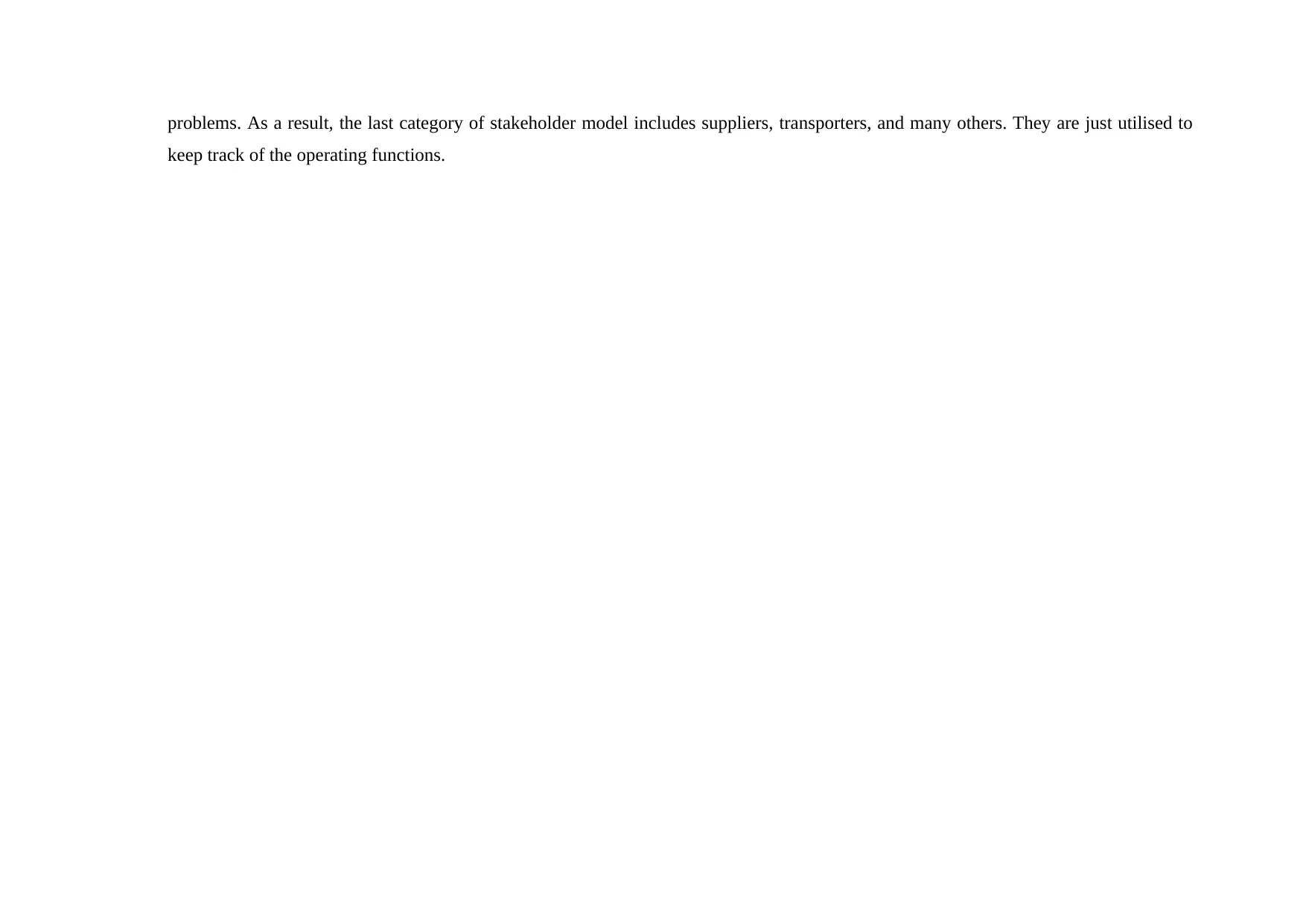
problems. As a result, the last category of stakeholder model includes suppliers, transporters, and many others. They are just utilised to
keep track of the operating functions.
keep track of the operating functions.
⊘ This is a preview!⊘
Do you want full access?
Subscribe today to unlock all pages.

Trusted by 1+ million students worldwide
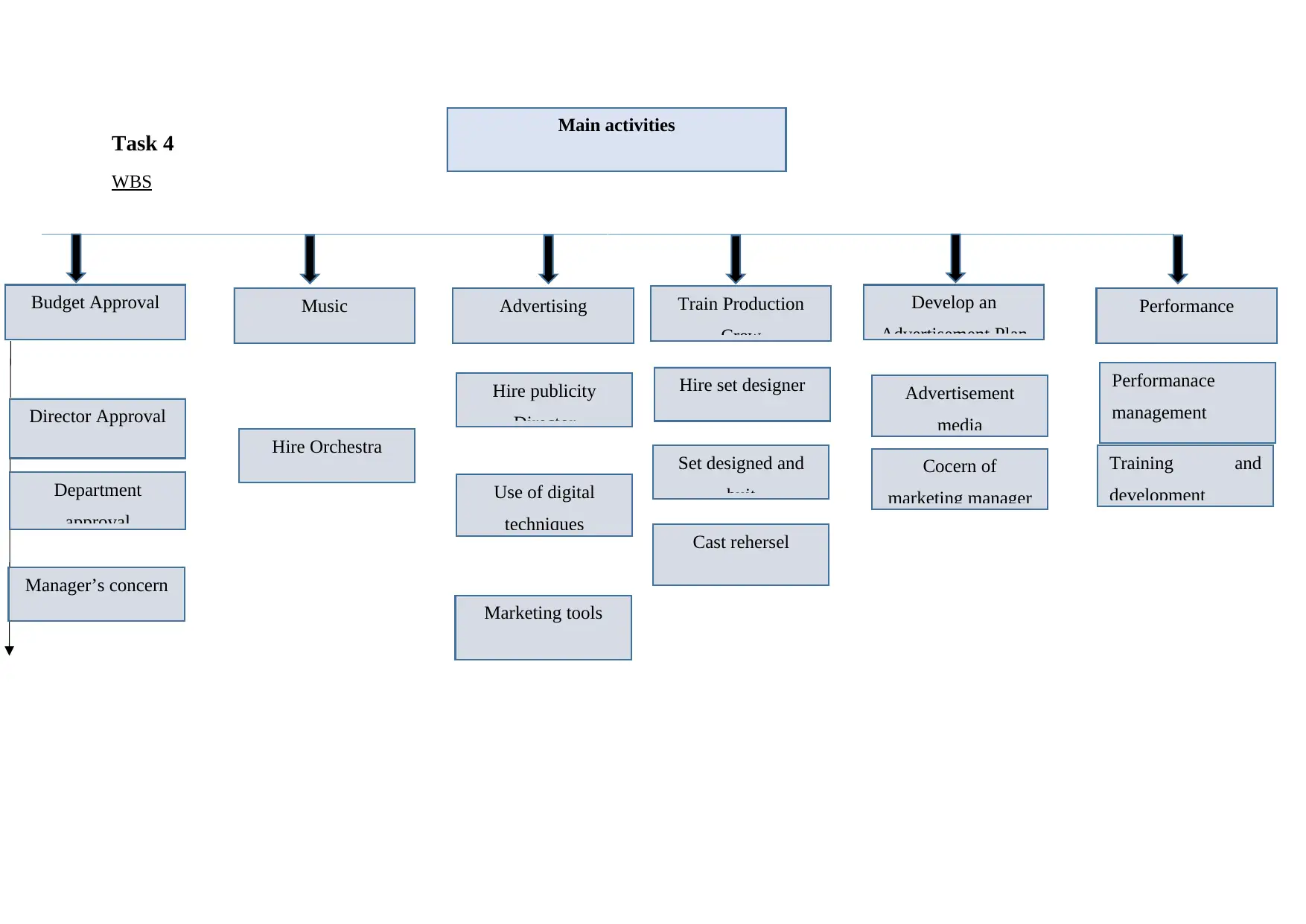
Task 4
WBS
Main activities
Budget Approval Music Advertising Develop an
Advertisement Plan
Train Production
Crew
Performance
Director Approval
Department
approval
Hire Orchestra
Manager’s concern
Hire publicity
Director
Use of digital
techniques
Marketing tools
Hire set designer
Set designed and
buit
Cast rehersel
Advertisement
media
Cocern of
marketing manager
Performanace
management
techniques
Training and
development
WBS
Main activities
Budget Approval Music Advertising Develop an
Advertisement Plan
Train Production
Crew
Performance
Director Approval
Department
approval
Hire Orchestra
Manager’s concern
Hire publicity
Director
Use of digital
techniques
Marketing tools
Hire set designer
Set designed and
buit
Cast rehersel
Advertisement
media
Cocern of
marketing manager
Performanace
management
techniques
Training and
development
Paraphrase This Document
Need a fresh take? Get an instant paraphrase of this document with our AI Paraphraser
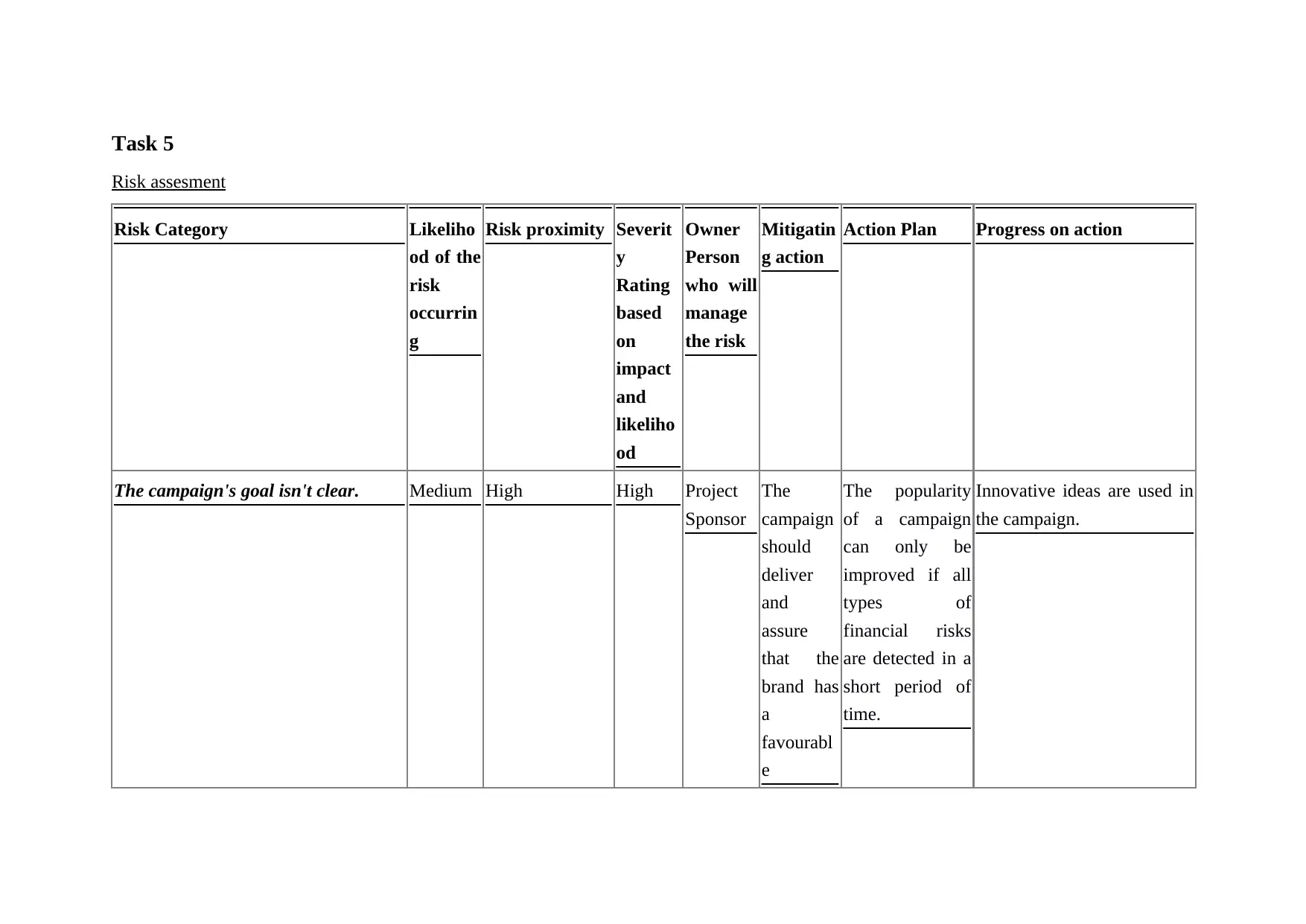
Task 5
Risk assesment
Risk Category Likeliho
od of the
risk
occurrin
g
Risk proximity Severit
y
Rating
based
on
impact
and
likeliho
od
Owner
Person
who will
manage
the risk
Mitigatin
g action
Action Plan Progress on action
The campaign's goal isn't clear. Medium High High Project
Sponsor
The
campaign
should
deliver
and
assure
that the
brand has
a
favourabl
e
The popularity
of a campaign
can only be
improved if all
types of
financial risks
are detected in a
short period of
time.
Innovative ideas are used in
the campaign.
Risk assesment
Risk Category Likeliho
od of the
risk
occurrin
g
Risk proximity Severit
y
Rating
based
on
impact
and
likeliho
od
Owner
Person
who will
manage
the risk
Mitigatin
g action
Action Plan Progress on action
The campaign's goal isn't clear. Medium High High Project
Sponsor
The
campaign
should
deliver
and
assure
that the
brand has
a
favourabl
e
The popularity
of a campaign
can only be
improved if all
types of
financial risks
are detected in a
short period of
time.
Innovative ideas are used in
the campaign.
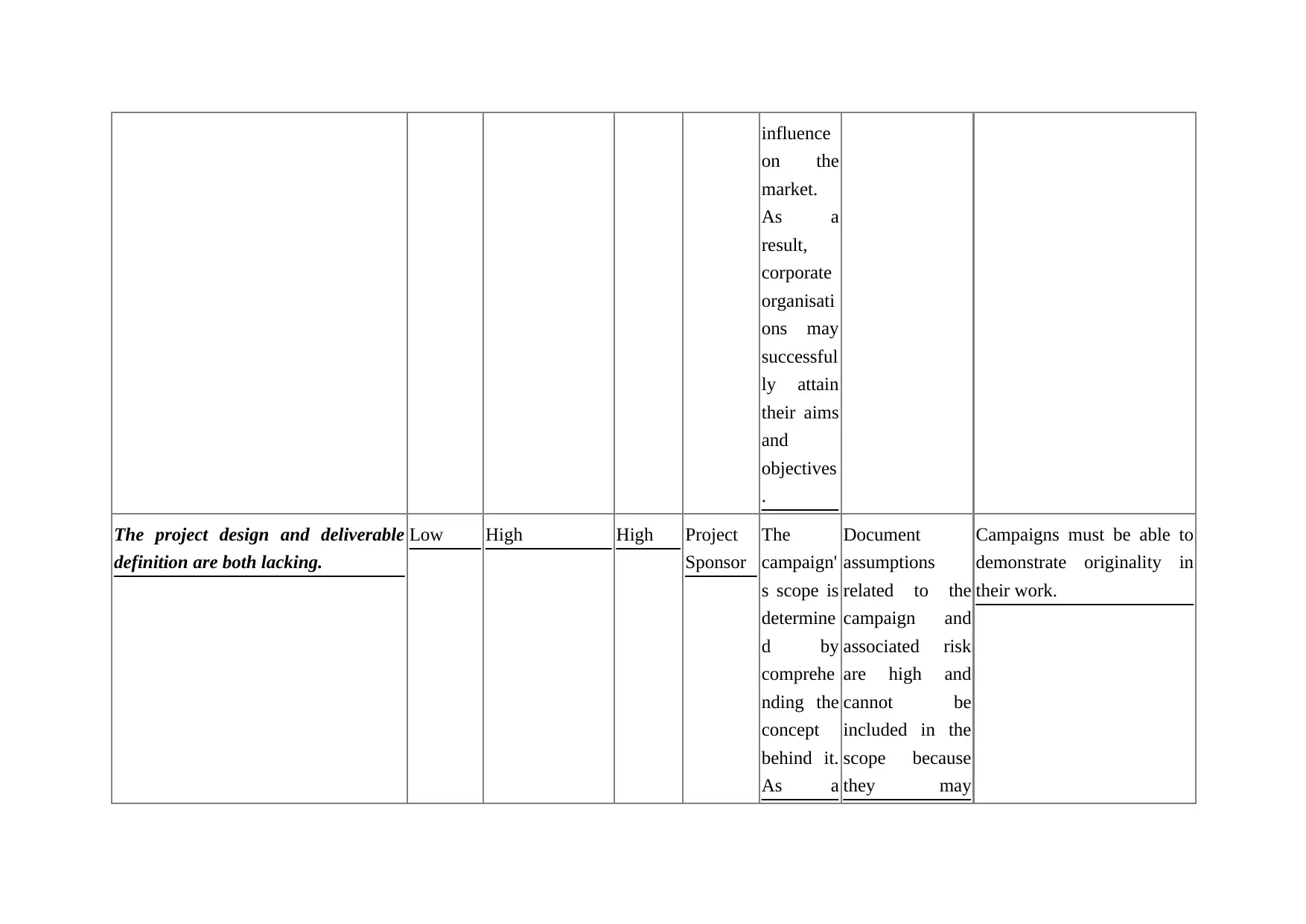
influence
on the
market.
As a
result,
corporate
organisati
ons may
successful
ly attain
their aims
and
objectives
.
The project design and deliverable
definition are both lacking.
Low High High Project
Sponsor
The
campaign'
s scope is
determine
d by
comprehe
nding the
concept
behind it.
As a
Document
assumptions
related to the
campaign and
associated risk
are high and
cannot be
included in the
scope because
they may
Campaigns must be able to
demonstrate originality in
their work.
on the
market.
As a
result,
corporate
organisati
ons may
successful
ly attain
their aims
and
objectives
.
The project design and deliverable
definition are both lacking.
Low High High Project
Sponsor
The
campaign'
s scope is
determine
d by
comprehe
nding the
concept
behind it.
As a
Document
assumptions
related to the
campaign and
associated risk
are high and
cannot be
included in the
scope because
they may
Campaigns must be able to
demonstrate originality in
their work.
⊘ This is a preview!⊘
Do you want full access?
Subscribe today to unlock all pages.

Trusted by 1+ million students worldwide
1 out of 20
Related Documents
Your All-in-One AI-Powered Toolkit for Academic Success.
+13062052269
info@desklib.com
Available 24*7 on WhatsApp / Email
![[object Object]](/_next/static/media/star-bottom.7253800d.svg)
Unlock your academic potential
Copyright © 2020–2025 A2Z Services. All Rights Reserved. Developed and managed by ZUCOL.